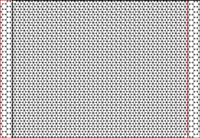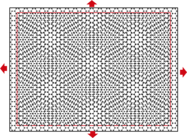Utilisateur:Spaguettovince/Brouillon
The concept of heterostrain was proposed in the context of materials science where two-dimensional materials can be stacked of top of each other and different strain applied to each layer.[1] In addition to twist, heterostrain can have important consequences on the electronic[2][3] and optical[4] properties of the resulting structure. As such, the control of heterostrain is emerging as a sub-field of straintronics in which the properties of 2D materials are controlled by strain.
Etymology[modifier | modifier le code]
The word heterostrain is constructed from the Greek prefix hetero- (different) and the noun strain. Il means that the two layers constituting the structure are subject to different strains. This is in contrast with homostrain in which the two layers as subject to the same strain. Heterostrain is designated as "relative strain" by some authors.
Manifestations and measurement of heterostrain[modifier | modifier le code]
For simplicity, the case of two gaphene layers is considered. The description can be generalized for the case of different 2D materials forming an heterostructure.
In nature, the two graphene layers usually stack with a shift of half a unit cell. This configuration is the most energetically favorable and is found in graphite. If one layer is strained while the other is left intact, a moiré pattern is generated by the beating of the two atomic lattices. The shape of the moiré pattern depends on the type of strain.
- If the layer is deformed along one direction (uniaxial heterostrain), the moiré is one dimensional.
- If the layer is strained in the same way along two directions (biaxial heterostrain), the moiré is a two-dimensional superstructure.
In General, one layer can be deformed by an arbitrary combination of both types of heterostrain.
Heterostrain can be measured by scanning tunneling microscope which provides images showing both the atomic lattice of the first layer and the moiré superlattice. Relating the atomic lattice to the moiré lattice allows to determine entirely the relative arrangement of the layers (biaxial, uniaxial heterostrain and twist).[5] Alternatively, if biaxial heterostrain is low enough, it is possible to determine twist and uniaxial heterostrain from the knowledge of the moiré period in all directions.[6]
Origin and impact of heterostrain[modifier | modifier le code]
Heterostrain is generated during the fabrication of the 2D materials stack. It can result from a meta-stable configuration during bottom up assembly[1] or from the layer manipulation in the tear and stack technique.[7] It has been shown to be ubiquitous in twisted graphene layers near the magic twist angle and to be the main factor in the flat band width of those systems.[2][3] It explains some of the sample variability which had previously been puzzeling.[3][8] Research is now moving towards understanding the impact of spatial fluctuations of heterostrain.[9]
- → N'hésitez pas à publier sur le brouillon un texte inachevé et à le modifier autant que vous le souhaitez.
- → Pour enregistrer vos modifications au brouillon, il est nécessaire de cliquer sur le bouton bleu : « Publier les modifications ». Il n'y a pas d'enregistrement automatique.
Si votre but est de publier un nouvel article, votre brouillon doit respecter les points suivants :
- Respectez le droit d'auteur en créant un texte spécialement pour Wikipédia en français (pas de copier-coller venu d'ailleurs).
- Indiquez les éléments démontrant la notoriété du sujet (aide).
- Liez chaque fait présenté à une source de qualité (quelles sources – comment les insérer).
- Utilisez un ton neutre, qui ne soit ni orienté ni publicitaire (aide).
- Veillez également à structurer votre article, de manière à ce qu'il soit conforme aux autres pages de l'encyclopédie (structurer – mettre en page).
- → Si ces points sont respectés, pour transformer votre brouillon en article, utilisez le bouton « publier le brouillon » en haut à droite. Votre brouillon sera alors transféré dans l'espace encyclopédique.
- Loïc Huder, Alexandre Artaud, Toai Le Quang et Guy Trambly de Laissardière, « Electronic Spectrum of Twisted Graphene Layers under Heterostrain », Physical Review Letters, vol. 120, no 15, , p. 156405 (DOI 10.1103/PhysRevLett.120.156405, lire en ligne, consulté le )
- (en) Zhen Bi, Noah F. Q. Yuan et Liang Fu, « Designing flat bands by strain », Physical Review B, vol. 100, no 3, , p. 035448 (DOI 10.1103/PhysRevB.100.035448, lire en ligne, consulté le )
- Florie Mesple, Ahmed Missaoui, Tommaso Cea et Loic Huder, « Heterostrain Determines Flat Bands in Magic-Angle Twisted Graphene Layers », Physical Review Letters, vol. 127, no 12, , p. 126405 (DOI 10.1103/PhysRevLett.127.126405, lire en ligne, consulté le )
- Huiyuan Zheng, Dawei Zhai et Wang Yao, « Twist versus heterostrain control of optical properties of moiré exciton minibands », 2D Materials, vol. 8, no 4, , p. 044016 (ISSN 2053-1583, DOI 10.1088/2053-1583/ac2d16, lire en ligne, consulté le )
- (en) A. Artaud, L. Magaud, T. Le Quang et V. Guisset, « Universal classification of twisted, strained and sheared graphene moiré superlattices », Scientific Reports, vol. 6, no 1, , p. 25670 (ISSN 2045-2322, DOI 10.1038/srep25670, lire en ligne, consulté le )
- (en) Alexander Kerelsky, Leo J. McGilly, Dante M. Kennes et Lede Xian, « Maximized electron interactions at the magic angle in twisted bilayer graphene », Nature, vol. 572, no 7767, , p. 95–100 (ISSN 1476-4687, DOI 10.1038/s41586-019-1431-9, lire en ligne, consulté le )
- (en) Kyounghwan Kim, Matthew Yankowitz, Babak Fallahazad et Sangwoo Kang, « van der Waals Heterostructures with High Accuracy Rotational Alignment », Nano Letters, vol. 16, no 3, , p. 1989–1995 (ISSN 1530-6984 et 1530-6992, DOI 10.1021/acs.nanolett.5b05263, lire en ligne, consulté le )
- Daniel E. Parker, Tomohiro Soejima, Johannes Hauschild et Michael P. Zaletel, « Strain-Induced Quantum Phase Transitions in Magic-Angle Graphene », Physical Review Letters, vol. 127, no 2, , p. 027601 (DOI 10.1103/PhysRevLett.127.027601, lire en ligne, consulté le )
- Naoto Nakatsuji et Mikito Koshino, « Moir\'e disorder effect in twisted bilayer graphene », Physical Review B, vol. 105, no 24, , p. 245408 (DOI 10.1103/PhysRevB.105.245408, lire en ligne, consulté le )



